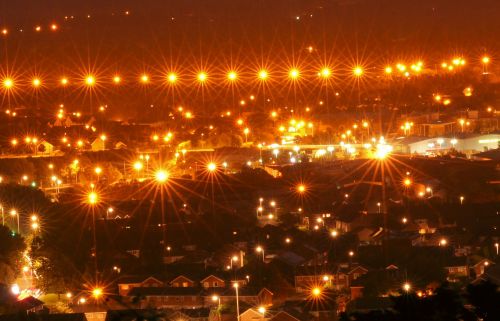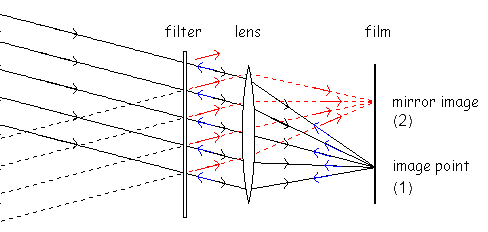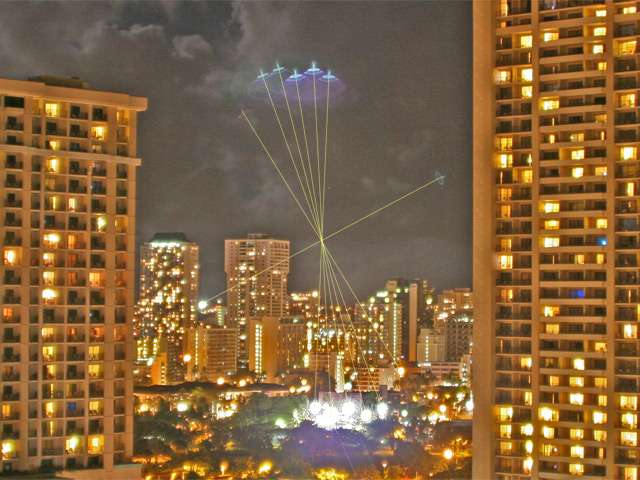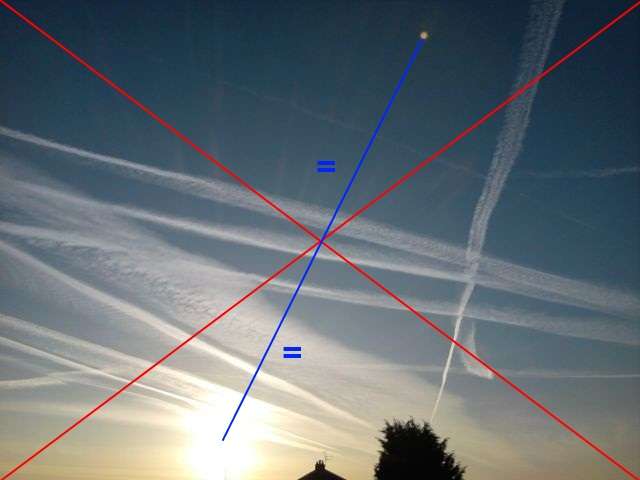It looks like you're using an Ad Blocker.
Please white-list or disable AboveTopSecret.com in your ad-blocking tool.
Thank you.
Some features of ATS will be disabled while you continue to use an ad-blocker.
share:
hello all my friends, here is a very interesting picture i came across on my friends Facebook. now he is a professional photographer for about 10-12
yrs maybe more. he took this picture from the lookout across from his house overlooking the Vanhorn bridge in Campbellton , NB, looking i would say
NNE towards quebec and the bay of chaleur.
i thought at first that it was a lens flare from the large spot light on the building, but after zooming in it looks and starts to get weird.. almost like a funnel shaped with a ring of lights and maybe like 3-4 lips or edges near the top, light comming out of the middle where it looks like it obviously is comming from the UFO( i say craft of some sorts) but ya there it is, im currently registering a photobucket account, the pics will be up shortly! give me 15 min or so..... and yes i know ppl, pics or it didnt happen, and yes it might only be a flare. but whatever it is, lets figure it out.
this isnt the first ufo he has seen also.
one love, peace on the middle east!!
ChefSpicY
i thought at first that it was a lens flare from the large spot light on the building, but after zooming in it looks and starts to get weird.. almost like a funnel shaped with a ring of lights and maybe like 3-4 lips or edges near the top, light comming out of the middle where it looks like it obviously is comming from the UFO( i say craft of some sorts) but ya there it is, im currently registering a photobucket account, the pics will be up shortly! give me 15 min or so..... and yes i know ppl, pics or it didnt happen, and yes it might only be a flare. but whatever it is, lets figure it out.
this isnt the first ufo he has seen also.
one love, peace on the middle east!!
ChefSpicY
Nice picture but it is a lens flare from the blue light thats near the middle.
The picture is a long exposure of about 20 seconds , you can tell by the star shapes coming off all the bright light sources
The picture is a long exposure of about 20 seconds , you can tell by the star shapes coming off all the bright light sources
edit on 2-12-2012 by PhoenixOD because: (no reason given)
reply to post by Chefspicy
Im a photographer myself, the star shapes on the lights is a standard feature of all night time long exposure shots.
Heres one i did myself

If i remember correctly ATS member elevenaugust has lots of great examples of the flare feature thats in your picture.
Im a photographer myself, the star shapes on the lights is a standard feature of all night time long exposure shots.
Heres one i did myself

If i remember correctly ATS member elevenaugust has lots of great examples of the flare feature thats in your picture.
edit on 2-12-2012 by PhoenixOD because: (no reason given)
reply to post by Chefspicy
I concur with PhoenixOD.
It's lens flare.
Blue light lower center = Blue light in sky. Yup.
I concur with PhoenixOD.
It's lens flare.
Blue light lower center = Blue light in sky. Yup.
i would say its that sort of artefact you see if light starts bouncing as a reflection on multiple lens surfaces inside the camera.
i saw this before, in a much similar setup
i saw this before, in a much similar setup
Originally posted by Chefspicy
iso 200. f 5.6. 15 seconds. 150 mm
if u understand photo lingo!
reply to post by PhoenixOD
thanks..Nikon?
edit on 2-12-2012 by PhoenixOD because: (no reason given)
First thing I noticed was that the angle of the flare indicated the exact line of sight to the blue light in the image.
First thing I would have assumed is lense flare.
It's like walking around 2000 years ago and people see someone with dark skin and a beard.
"Is that jesus? He has a beard."
"No, that's actually a woman. Don't stare at her beard."
"Is that jesus? He's wearing a robe."
"No, that's Bob, and you know it's Bob."
"Is that jesus? He's got a crown of thorns."
"No, that's a cow."
"Is that jesus? He..*thwack*"
"WILL YOU STOP ASKING IF EVERYTHING IS JESUS... USE YOUR BRAIN!"
No offence op, good to ask, but.. I'm waiting for the day a cigar is more than a cigar.
First thing I would have assumed is lense flare.
It's like walking around 2000 years ago and people see someone with dark skin and a beard.
"Is that jesus? He has a beard."
"No, that's actually a woman. Don't stare at her beard."
"Is that jesus? He's wearing a robe."
"No, that's Bob, and you know it's Bob."
"Is that jesus? He's got a crown of thorns."
"No, that's a cow."
"Is that jesus? He..*thwack*"
"WILL YOU STOP ASKING IF EVERYTHING IS JESUS... USE YOUR BRAIN!"
No offence op, good to ask, but.. I'm waiting for the day a cigar is more than a cigar.
Originally posted by PhoenixOD
Nice picture but it is a lens flare from the blue light thats near the middle.
The picture is a long exposure of about 20 seconds , you can tell by the star shapes coming off all the bright light sources
edit on 2-12-2012 by PhoenixOD because: (no reason given)
I'd say, exactly this. The artifact in the sky has the typical shape of a lens flare, and, if you notice, the tail is pointing down to the source, which is the green laser light below. This indicates a long exposure time.
To the untrained eye maybe convincing, but many will see this on first glance.
Originally posted by PhoenixOD
If i remember correctly ATS member elevenaugust has lots of great examples of the flare feature thats in your picture.
Yes! And thanks for the reminder.
Here's what I use to say when it's about Lens flares:

How it works:
The flare is generally due to the presence of a protective filter in the camera, after the lens. It also works however with some lens without this filter.
Anyway, the flare is a mirror ghost of the original bright object, with the image center serving as a point of symmetry (or point reflection).

Black arrows indicate the light rays of a distant bright light source that form a regular image point on the film (1). Values for the reflectance of undeveloped photographic film vary from 15% to 40% [see sources 1,2], which makes the film a much stronger reflector than any optical component in the lens.
So, a significant percentage of the light is reflected off the film, partly specular and partly diffuse. (For convenience, we will consider that paths of the reflected light are the same and thus are already drawn for the incident light).
Thus, the blue arrows indicate light reflected from the film. This light encounters the filter, which specularly reflects a small fraction (red arrows). The red rays are parallel and consequently focused onto a point on the film. (2)
The virtual source of the mirror point is traced by the dashed black lines. Note that the blue rays reflected by the film seem odd from the viewpoint of specular reflection; they merely illustrate the fact that all light rays that originate from a single point on the film, and which are collected by the lens, emerge parallel at the filter.


Not all light reflected off the film makes it back to the mirror point. The presence of an aperture stop further reduces the number of rays allowed to return to the film.
The risk of being confronted with filter flare reduces with a smaller focal length, a smaller aperture (larger F-number), an increased separation of highlights from the image center, and with a better filter quality. However, by far the most secure way to avoid this type of flare is to omit the filter altogether.
People who want to try their luck with UFOs may improve their chances by using a tele lens at a large aperture. I guess that, instead of a filter, a lens element with a flat face could also give rise to mirror ghosts.
[1] SPSE handbook of photographic science and engineering, edited by Woodlief Thomas Jr., John Whiley & sons, p. 204 (1973).
[2] Sidney F. Ray, Applied photographic optics, 3rd ed., Focal Press, p. 139 (2002)
Also, worth a read:
UFO misidentifications: Lens flares samples
UFO?.......No!
reply to post by Chefspicy
Is that a lens flare in my avatar? What's going on here?
I guess we will find out December 21, 2012.
That is the day that Earth 3D comes to an end. Good riddance!
Is that a lens flare in my avatar? What's going on here?
I guess we will find out December 21, 2012.
That is the day that Earth 3D comes to an end. Good riddance!
Originally posted by PhoenixOD
the star shapes on the lights is a standard feature of all night time long exposure shots.
Absolutely not true, although longer exposure may accentuate them.
The clue is in the name, diffraction spike :- They are caused by diffraction, which is at it's greatest when a lens aperture is stopped down.
Next time you are out shooting a night scene, try shooting with a wide open aperture as well as stopped down, and then compare the results.
edit on 3-12-2012 by FireballStorm because: typo
reply to post by FireballStorm
The link you provided says "They are artifacts caused by light diffracting around the support vanes of the secondary mirror. " but obviously there is only 1 mirror in a SLR.
I think to reduce the star effect with the f stop would just mean that all you would be able to see is the light and everything else would be to dark. So while it may be possible to reduce them with an F stop its not very likely in normal photography where you want other features in the picture other than the light source itself like the one in the OP.
Ill try drastically adjusting the f stop next time im out doing night time long exposure and see the results.
The link you provided says "They are artifacts caused by light diffracting around the support vanes of the secondary mirror. " but obviously there is only 1 mirror in a SLR.
I think to reduce the star effect with the f stop would just mean that all you would be able to see is the light and everything else would be to dark. So while it may be possible to reduce them with an F stop its not very likely in normal photography where you want other features in the picture other than the light source itself like the one in the OP.
Ill try drastically adjusting the f stop next time im out doing night time long exposure and see the results.
reply to post by winofiend
I almost hate to do this bur ask a democrat if a cigar is just a cigar. Ms Lewinski might be able to tell some stories
I almost hate to do this bur ask a democrat if a cigar is just a cigar. Ms Lewinski might be able to tell some stories
new topics
-
A Warning to America: 25 Ways the US is Being Destroyed
New World Order: 4 hours ago -
President BIDEN's FBI Raided Donald Trump's Florida Home for OBAMA-NORTH KOREA Documents.
Political Conspiracies: 9 hours ago -
Maestro Benedetto
Literature: 11 hours ago -
Is AI Better Than the Hollywood Elite?
Movies: 11 hours ago
top topics
-
President BIDEN's FBI Raided Donald Trump's Florida Home for OBAMA-NORTH KOREA Documents.
Political Conspiracies: 9 hours ago, 28 flags -
Gaza Terrorists Attack US Humanitarian Pier During Construction
Middle East Issues: 16 hours ago, 8 flags -
A Warning to America: 25 Ways the US is Being Destroyed
New World Order: 4 hours ago, 8 flags -
Las Vegas UFO Spotting Teen Traumatized by Demon Creature in Backyard
Aliens and UFOs: 15 hours ago, 6 flags -
2024 Pigeon Forge Rod Run - On the Strip (Video made for you)
Automotive Discussion: 15 hours ago, 4 flags -
Is AI Better Than the Hollywood Elite?
Movies: 11 hours ago, 3 flags -
The functionality of boldening and italics is clunky and no post char limit warning?
ATS Freshman's Forum: 17 hours ago, 1 flags -
Maestro Benedetto
Literature: 11 hours ago, 1 flags
active topics
-
A Warning to America: 25 Ways the US is Being Destroyed
New World Order • 6 • : theatreboy -
Supreme Court to decide if states can control fate of social media
Education and Media • 14 • : SMMPanelPro -
Gaza Terrorists Attack US Humanitarian Pier During Construction
Middle East Issues • 35 • : Lazy88 -
Definitive 9.11 Pentagon EVIDENCE.
9/11 Conspiracies • 426 • : Lazy88 -
Alternate Electors vs Fake Electors - What is the Difference.
2024 Elections • 117 • : ADVISOR -
-@TH3WH17ERABB17- -Q- ---TIME TO SHOW THE WORLD--- -Part- --44--
Dissecting Disinformation • 691 • : Imbackbaby -
Victoria government has cancelled the commmonwealth games, no money.
Regional Politics • 3 • : nazaretalazareta -
President BIDEN's FBI Raided Donald Trump's Florida Home for OBAMA-NORTH KOREA Documents.
Political Conspiracies • 19 • : ADVISOR -
When an Angel gets his or her wings
Religion, Faith, And Theology • 22 • : AcrobaticDreams1 -
King Charles 111 Diagnosed with Cancer
Mainstream News • 321 • : FlyersFan
